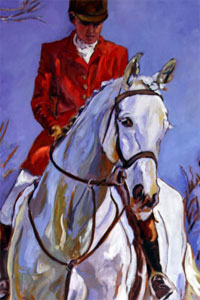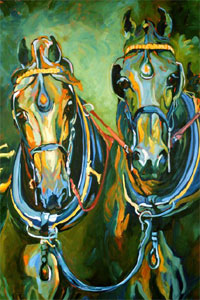Equestrian and Sporting Art by Gail Guirreri-Maslyk
 Gail Guirreri-Maslyk is
an equestrian, sporting, landscape and portrait fine artist working in oil
on canvas. Living in Virginia horse country, inspiration is abundant from the many local equestrian
sports including fox hunting, polo, grand prix jumping, show hunters, carriage driving, dressage,
and more. The unspoiled country side is stunning out her studio balcony and has been painted many
times in her Rectortown Landscape studies. Gardens, farm animals and wildlife are captured in a moment
with quick study paintings. Like all her work, these are free flowing with strong brush strokes easily
recognized as iconic 'Gail' paintings.
Gail Guirreri-Maslyk is
an equestrian, sporting, landscape and portrait fine artist working in oil
on canvas. Living in Virginia horse country, inspiration is abundant from the many local equestrian
sports including fox hunting, polo, grand prix jumping, show hunters, carriage driving, dressage,
and more. The unspoiled country side is stunning out her studio balcony and has been painted many
times in her Rectortown Landscape studies. Gardens, farm animals and wildlife are captured in a moment
with quick study paintings. Like all her work, these are free flowing with strong brush strokes easily
recognized as iconic 'Gail' paintings.
Gail balances her time between art, computer graphics and programming, her partner's veterinary practice Dr. William B. Ley DVM, MS DACT (VAhorsevet.com), and her own breeding farm of Holsteiner sport horses (Cloverlone.com). Not surprising, her own breeding program has been directed towards breeding a colorful spotted Holsteiner with appaloosa coat pattern since 1986. No matter what form of her passion, painting, programming or time at the barn, Gail's days begin and end with horses.
Reproductions, prints, and other gift items are now always available.
As an artist, Gail has been featured in magazines such as The Chronicle of The Horse, Sidelines, Horses in Art, Middleburg Eccentric, and The POST (as well as other newspapers on the East Coast). Gail has been invited to show often at a variety of major events including MFHA Centennial Tour, Kentucky Derby, HITS, ASHA World Championships, and the Virginia State Senate among others. She also donates her efforts to charities helping hospice, humane foundations, youth development, and equine rescue/retirement. She was a founding board member of Animal Rescue Fund (arfrescue.org) and show artist for Roanoke Valley Horse Show (a non-profit show) since 2000.
Her work has been on many covers including:
- The Chronicle of the Horse (Vol. LXX, NO. 31 and Vol.LXXI, NO.23)
- The Roanoke Valley Horse Show (2000 to present)
- Horses in Art magazine (2008)
- Friesian Grand Nationals (2005, 2007, 2011, 2012)
- IALHA National Championships, 2007
- HITS Finals poster
Gail's future dreams are to help improve and solve business issues that affect the equine industry and the welfare of horses, preventing some horses from needing to be rescued.
In Gail's studio
"My studio time is precious time. The door is shut and all else quiet and calm; that means the horses are happy. Many artists can come and go from a canvas and keep their intention and focus. My process is more feverish and responsive with increasing momentum. To leave a canvas would break the spell of emotion and many layers of subconcious planning. A canvas left more than a day would dry too much. Fluid 'wet on wet paint' is an important aspect to my final effect."
My Process
"I start with a wash drawing, accuracy is worked in a free and lose manner. Does not sound possible? There is a balance between control and letting go when drawing. That would go for any part of painting actually. Drawings are only in paint, never pencil and wash color is carefully chosen. My palette is always minimal with as few as three transparent colors and white, which is used only in final stage. I started painting in watercolor in the early 90's but did not get the saturation I was after. With transparent oils I get the best of watercolor with an extra punch of brightness and of course texture."
"After a day the wash drawing is dry enough to paint over and pull some color through in heavy brush strokes or wet enough to touch up a drawing if I see it differently. One might think my canvases are slightly careless at first glance. In actuality they are well planned in layers of color combination from base color to final highlights. There is little room for error in this process as all colors must combine with purity. I consider my best work to be accomplished in just a few hours."
What motivates me as an artist?
Capturing power of athletic motion in a pleasing composition would be my favorite inspiration. It is important to me to find just the right angle to see curvature of muscles and angle to bone. Generally these paintings need to be on the larger size to allow for freedom in my elbow and brush size. I don't like using anything smaller than a 6.
Witnessing glowing colors and moments of light I see in nature everyday motivates me to get back to painting sooner rather than later. I do tend to go through palatte color phases depending on the colors of landscape during the current season. I may see cobalt tourquois in a tree trunk or in some grass blowing. I keep these mental notes and take them back to the studio to explore further.
Work Ethic
"I was amused today when reading about young Degas getting advice from his father:"
“You mention the boredom you feel at doing portraits; you’ll really have to overcome this eventually because portraiture will be the finest jewel in your crown. The question of cash, in this world, is so serious, so pressing, so crushing even, that only idiots can lose sight of it or scorn it. It’s not a question of having to come down to that level, but you need to be able to put up with the irritations that go with it. To believe that, in this world, you can always indulge your own whims and take no account of the necessities of existence is a foolishness that you pay dearly for, I’ve told you again and again.” – Auguste de Gas
"I prefer to envision old masters having nothing but perfect days in the beautiful countryside of France with no financial pressures! Ideally financial pressures are kept seperate from my painting but I also understand the requirement of work ethic. Even coming and going from my studio the way I do I have long since made it past the 'in gate jitters' of starting a canvas. Allowing a painting to evolve somewhat on it's own can be a wonderful surprise. I allow the 'happy accident' and always willing to learn from it. In the last year I found my best warm up to come from computer programming. The awareness of every character, space and work flow of code gets my brain calculating on many layers. Drawings take a quarter of the time. This is a completely unexpected finding and I am most thankful for it. I was concerned programming would get in the way of my painting but in actuality it has improved it."
"There are many earlier works sold wet off the easel that I would have enjoyed spending more time studying. I think all artists find wonder in a completed painting, especially those that painted themselves. My personal goals are to make programming my financial concern and give my painting the freedom to be commited only to itself."

